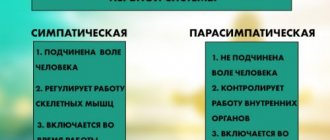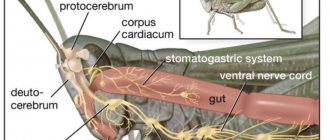The nervous system controls the functioning of the entire body, so any disturbances in it have a negative impact on mental and physical health. Meditation for healing the nervous system restores the nerves that transmit signals between the brain/spinal cord and internal organs, allowing them to function normally. In addition, such practices are an effective tool that guarantees quick stress relief, elimination of psychological tension and normalization of the emotional background without the use of medications and other treatments. Such meditations are especially useful for women, since they spend much more effort on relaxing and restoring the nervous system than men.
The influence of practice on the nervous system
The emotional state and functioning of internal organs depend on how efficiently the nervous system works. When the autonomic system works intermittently, this is fraught with the development of psychosomatic disorders and a decrease in quality of life.
Being in this state, a person constantly experiences anxiety and a feeling of helplessness. Experiencing this, people do not see their own responsibility for what is happening and do not strive to make efforts to correct the situation. They place all the blame on external circumstances or people around them.
When the nervous system does not work correctly, people suffer from neuroses, depression, and persistent fatigue. This causes disruption of the cardiovascular system and autoimmune diseases. To eliminate these ailments, meditative practices are recommended that help eliminate insomnia, restore the emotional background, and relieve physical stress.
Benefits of practicing meditation for stress relief and deep relaxation:
- restoration of heart rate, normalization of blood pressure;
- the blood receives more oxygen due to special breathing techniques;
- Less stress hormones enter the body, which has a positive effect on the functioning of the nervous system.
Types of healing practices
Meditation for healing the nervous system and psyche can be performed in different techniques, which are divided into three areas:
- respiratory
- visualized
- managed.
There is also a special practice that involves working with a light source (candle flame).
Breathing training
Meditation for the treatment and restoration of the nervous system and psyche using breathing is performed in several versions. The most common of them are “Breath Square” and Ujjai.
"Breathing Square"
This simple practice, suitable even for beginners, helps relieve tension in the mind and body. Relaxation is achieved within the 2 minutes that the exercise is designed to take.
The procedure is as follows:
- sit or stand with a straight back;
- place your palms on the diaphragm area;
- count slowly to 5, take a deep breath;
- hold the air for 5 counts, exhale.
Repeat as many times as necessary to completely calm down.
Ujjai
When performed regularly, the Ujjai technique helps restore the nervous system, depleted by chronic stress or constant tension. To carry it out you need:
- sit on your knees or in the lotus position with a straight back;
- perform several slow deep breathing cycles;
- when relaxation occurs, switch to nasopharyngeal breathing, slightly tensing the muscles of the larynx.
When performed correctly, a slight wheezing sound should appear as you inhale.
Visualization
Visualization techniques are widely used in yoga and various esoteric practices. Meditation for the treatment of the nervous autonomic system, based on visualization, helps restore energy balance and mental balance.
It is done quite simply:
- sit with a straight back;
- Place your hands on your knees, palms up;
- close your eyelids, breathe deeply and slowly;
- remember pleasant moments in which you felt happiness and peace;
- Immerse yourself in these feelings and try to hold them for 10 minutes.
Alternatively, you can imagine all your worries, problems and other negativity in the form of a stone or other inanimate object, and then isolate yourself from it with a wall. Feel the calm and tranquility that follows.
Guided techniques
Guided practices use suitable audio or video recordings. This option is best suited for beginners, since everything that needs to be done is explained by the presenter, usually accompanied by relaxing music or sounds of nature.
In this case, you need to meditate according to this scheme:
- take a comfortable position, relax, close your eyelids;
- stop internal dialogue;
- inhaling, feel how the body is filled with light, and with the exhalation all the negativity comes out;
- turn on the audio or video recording and completely immerse yourself in the meditative process.
You need to choose a guided meditation taking into account the topic, duration of the session, and the voice of the teacher. It should evoke pleasant emotions, and fill the text with strength and energy.
Meditation on a candle
Meditation for healing nerves using light sources is suitable not only for adults, but also for children. The best way to do this is to use a candle, since watching a burning fire quickly calms you down and allows you to get rid of obsessive thoughts.
Before meditating, you need to sit so that the fire is located about half a meter directly in front of your eyes. Next steps should be as follows:
- stop your gaze on the flame, observe the combustion process;
- then close your eyelids and try not to think about anything;
- Having achieved mental silence, look again at the candle fire;
- listen to your feelings, feel how the flame relaxes the mind and body;
- mentally send all your problems into the fire and imagine how they burn;
- when all the negativity disappears, close your eyelids again and imagine that the fire is now glowing in the heart chakra, and then spreading throughout the body, going beyond it and creating a cocoon of light;
- feel calm and protection in this cocoon, hold these sensations within yourself for 5 minutes;
- end the session, open your eyes.
You can meditate to calm music. It is not necessary to follow all the recommendations, you can just look at the fire, and it will do all the work, since fire is considered a manifestation of the Divine and itself sees what is subject to destruction in the subtle world.
Daily meditation for 2 weeks will significantly improve mental and physical health, which will lead to normalization of the situation in all areas of life. The main thing is to let the light into your soul.
Three execution techniques
Meditation does not require special equipment or effort of concentration. As a rule, it is performed while sitting with your eyes closed.
Breathing exercises
A brain that receives a sufficient amount of oxygen works more efficiently, which means that the decisions a practitioner makes become more balanced.
- Prepare a practice area.
- Find a comfortable position and close your eyes.
- Watch every inhalation and exhalation, trying to keep them smooth and deep.
- Relax all the muscles in your body.
- When all unpleasant emotions go away, slowly take a deep breath and open your eyes.
After completing your meditation, do not make sudden movements. Allow yourself to integrate into current affairs in a measured way. Meditation practice is good for beginners, as it is easy to perform and allows you to regain a sense of peace and harmony. The functions of the respiratory system return to normal, which has a positive effect on brain function.
Audio recordings
A good solution for those who have just come to the practice would be audio meditation. All you need is any device that can play the recording. You can practice in transport, walking in the park, at work or school, lying in the bathroom. In a public place you can listen to recordings using headphones. If they are accompanied by instructions from the speaker for any actions, it is better to do it at home so as not to disrupt the structure of the practice.
Calming Meditation:
Calm your nerves in 8 minutes:
Visualization
Visualization is a very powerful tool that has a beneficial effect on the practitioner. The essence of this method is to imagine an object that generates pleasant experiences in the brain and transfers them to real life. Such meditation allows you to heal the nervous system, restores harmony, eliminates illnesses, and restores harmony of body and mind.
Technique:
Legendary meditation course without payment We recommend! The most popular meditation course for beginners in Russian. More than 100 thousand people have already learned to meditate. Try it yourself. Read more.
- Prepare your practice room.
- Position your body in a comfortable position.
- Relax your body and focus on your breathing.
- Clearly visualize what you sincerely strive for.
- Allow the emotions of joy, happiness, and calm to take over you.
- To complete the practice, take a deep breath and open your eyes.
When practicing visualization meditation, try to see not an abstract image, but a real picture that you sincerely strive for. In order to achieve harmony, imagine a place where you feel good and calm: the sea coast, mountain peaks, forest clearing. Your place should be secluded, away from the hustle and bustle and people.
Deep relaxation before bed
Try this simple technique that allows you to enter the halls of the parasympathetic nervous system:
Meditation to calm the nervous system: types of practices
When you hear the word “meditation”, the following picture most likely pops up in your mind: a person with a relaxed and peaceful face, with eyes closed, sits in the lotus position. His hands are on his hips, his back is straight, a mysterious half-smile wanders across his face... Did I guess right? So, it turns out that meditation heals the nervous system and psyche
can be not just silent, but also dynamic! It is allowed to practice in a lying position or sitting on a chair, on a sofa, in an armchair. This fact made me happy because my physical condition did not allow me to take the lotus position, and my frayed nerves needed healing.
Meditation of the nervous system: types of practices
Competent sources claim that practices aimed at relaxation, immersion, relief from stress and anxiety can be divided into the following types:
- respiratory;
- managed;
- visualizing.
According to the way they perceive reality, people are divided into auditory, visual, and kinesthetic (sensual) learners. Depending on this, it is worth choosing the type of meditation to calm the nervous system
which will work best for you.
Do you perceive information best by hearing? An audio-guided meditation or guided practice may be right for you.
Are tactile sensations important to you? Then, most likely, breathing meditation will give you the most pleasure.
If you find it easier to perceive information through your eyes, then try experimenting with visualization techniques.
Do you want to learn how to build your natal chart to see your hidden potential and purpose, know your weak and strong points and upgrade them to avoid many problems? Register via the link to our free webinar, where we will tell you how to create your own individual horoscope and learn how to fulfill your desires using a special technique.
Top 3 Meditations for Healing the Nervous System
I note that I am expressing my personal, subjective opinion. It is quite possible that mantra meditation, dynamic (dance) practice, zazen (contemplation of emptiness) or vipassana (silent meditation) are more suitable for you to get rid of stress. There is such a thing! I share with you the practices that I have tried on myself. They turned out to be not only simple, but also quite effective in combating stress, anxiety and emotional burnout. I also recommend reading how to start meditating. The article is perfect for beginners in this matter.
Try some healing meditations.
Breathing techniques
There is a whole area of yoga dedicated to breathing exercises. Pranayama is as important as performing asanas, and many varieties of this practice produce such a strong effect that they cannot be done without training and the guidance of an instructor. I will tell you about simple and accessible exercises.
"Breathing Square"
This practice is performed for 2 minutes (over time the duration can be increased). To record the time, I advise you to use a stopwatch (set a pleasant signal to gently come out of a state of relaxation). Turn off the Internet and any notifications so that you are not distracted by extraneous sounds.
Meditation treatment of the nervous system
carried out in a sitting or standing position with a straight back, this is a prerequisite.
If you find it difficult to concentrate on your breathing and read at the same time, you can try paying attention to the temperature of the air you inhale and exhale.
It is important that during practice your back is straight but your body is relaxed. Do not raise your shoulders to your ears, do not inflate your stomach as you inhale.
Once you have mastered this simple exercise, you can make it a little more complicated: breathe alternately through your left and right nostrils, very calmly, thoughtfully and focused. You can do five cycles of breathing through the left nostril, then five cycles through the right.
Try to master “yogic breathing”. This is a deep and measured breath, first through the stomach, then through the chest and collarbones. As you exhale, the air leaves the body in the opposite order: first the collarbones fall, then the chest and finally the stomach.
Nervous System Meditation: Visualization
If I do breathing practices in the morning, then nervous system meditation works great in the afternoon, when I need to reboot.
I would like to note: you can visualize anything that brings you a feeling of joy, peace, and tranquility. Experienced practitioners offer basic ideas for visualization, but this activity is creative, there are no restrictions. Give in to your own imagination and relax!
Start by taking a comfortable body position. You can sit on the floor in a lotus, half-lotus, or simply with your legs extended. If it is difficult to sit with a straight back, move to a vertical surface and prop up a pillow. By the way, I also highly recommend placing pillows, a pouf, or a special yoga brick under your buttocks and knees (hips).
- Close your eyes and focus on your breathing.
- When your breathing calms down, begin to imagine a beautiful place - a seashore, a forest, a cave, a garden, mountains. Try to examine it with your inner eye in great detail.
- When you feel that you are already “there” and not in the room where you are meditating, visualize anxious thoughts and worries in the form of a specific object. It could be a stone, a ball, a crumpled piece of paper.
- And then everything depends on the plot of your meditation, if you are on the shore of a pond, throw it as far into the water as possible, if at a fire, burn it, if in the forest, then bury it in a hole or cover it with a heap of dry leaves, in a word, get rid of it.
Feel calm, liberated, light. Imagine how the energy of light and joy fills every cell of your body. Fix this state and gradually come out of meditation.
Relaxing Meditation
Meditation for the nervous system
may work better than any sleeping pill or sedative. I do this type of meditation in the evening, in bed, just before going to bed.
In order for the technology to work, I advise you not to drink tea or coffee in the afternoon and not to use gadgets at least an hour before falling asleep. This simple technique helps you quickly fall into deep sleep, relaxing not only the gross, but also the subtle body.
- Take a comfortable position. Yogis recommend falling asleep on your back, in the shavasana pose, with your arms and legs spread to the sides. The limbs should be at a short distance from the body, the legs should not be crossed.
- Lie down and watch your breathing. When it becomes smooth and calm, begin to slowly move your attention around the body. Shift your attention to different parts of the body. There is no need to strain your body or move, everything happens only in your mind.
I usually start the journey from the tips of my fingers and toes. Then I mentally walk through my legs, rising from bottom to top, examining my torso, arms, head, back. It is important not to forget about the back surface of the body and the facial muscles.
Usually during the day we don’t even think about how tense our neck and shoulders are. If we are stressed, we tense our forehead, and our lips may become pursed or curled. It is important to focus on the point between the eyebrows, the place where the “third eye” is located. This is a meditation of the nervous system
without medications or unpleasant procedures. Tested for yourself!
I hope that my experience is useful to you. Share your impressions and experiences of practices to relax the body and mind. I wish you health and inner harmony in our difficult times!
Are you interested in learning astrology for beginners and getting a new profession? Start learning Vedic astrology now! At Lakshmi-Ameya Institute you will gain knowledge that will help you improve your life and the lives of your loved ones. And strology - studying on your own will not give you what you will get by studying with experienced mentors. Our teachers are hereditary astrologers, Gurus from India with extensive experience, having a scientific degree in astrology. We give you knowledge and practice, teach you how to create a personal brand, tell you how to promote yourself on the market, help you find your first clients and change your life. We provide not only online training in astrology , but also other Vedic sciences: palmistry, numerology, Ayurveda.
Our students have the opportunity to take part in various activities, offline meetings, conferences and other projects of the Institute: Offline conferences and meetings with teachers ,
Spiritual tour to India , Astroclinic , Seva - food of the world , Karmadel , Astrobattle .










